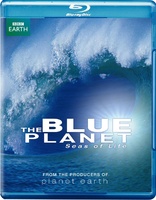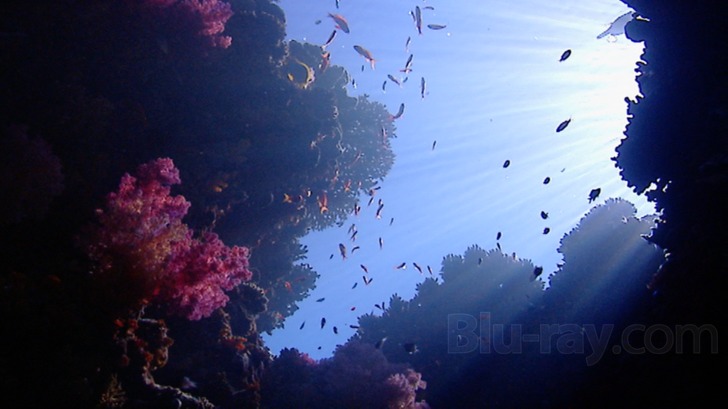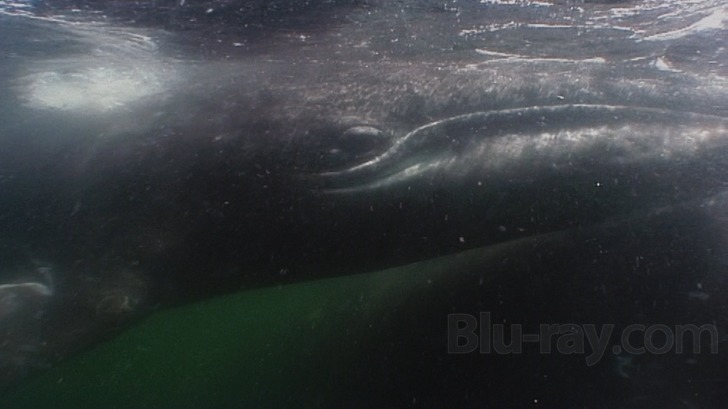The Blue Planet: Seas of Life Blu-ray Movie
HomeThe Blue Planet: Seas of Life Blu-ray Movie 
Warner Bros. | 2001 | 389 min | Not rated | Apr 09, 2013
Movie rating
8.4 | / 10 |
Blu-ray rating
| Users | 3.0 | |
| Reviewer | 3.0 | |
| Overall | 3.0 |
Overview
The Blue Planet: Seas of Life (2001)
Landmark eight-episode BBC series narrated by Sir David Attenborough
Narrator: David Attenborough| Documentary | Uncertain |
| Nature | Uncertain |
Specifications
Video
Video codec: MPEG-4 AVC
Video resolution: 1080p (upconverted)
Aspect ratio: 1.78:1
Original aspect ratio: 1.78:1
Audio
English: DTS-HD Master Audio 5.1
Subtitles
English SDH
Discs
50GB Blu-ray Disc
Three-disc set (3 BDs)
Packaging
Slipcover in original pressing
Playback
Region A, B (C untested)
Review
Rating summary
| Movie | 4.0 | |
| Video | 1.5 | |
| Audio | 3.0 | |
| Extras | 4.0 | |
| Overall | 3.0 |
The Blue Planet: Seas of Life Blu-ray Movie Review
Unconverted standard definition video all but sinks the ship...
Reviewed by Kenneth Brown April 8, 2013For some, natural history documentaries and series begin and end with Planet Earth and its 21st century progeny. But the BBC has been producing outstanding programming for the better part of seven decades, from radio broadcasts like The Naturalist in the 1940s to groundbreaking television like Life on Earth in the late '70s to, most recently, stunning, riveting shows like Africa. Established in 1957, the BBC Natural History Unit has been on the front lines with many a landmark series. Along with renowned naturalist (and British national treasure) Sir David Attenborough, who joined the BBC in 1952, the BBC Natural History Unit has made dramatic strides in the field, eliminating the once unbridgeable chasm between viewers around the world and some of the most amazing sights on Earth, above the waves and below.

One of those pre-Planet Earth series is executive producer Alastair Fothergill's The Blue Planet: Seas of Life. Filmed over the course of five immensely challenging years, it remains a fascinating eight-episode exploration of the world's oceans, beautiful underwater expanses and coastal vistas, and rich, diverse sealife, with narration from David Attenborough and music composed by five-time Academy Award nominee George Fenton. The game-changing culmination of what came before it and the inspiration for much of what has come after, The Blue Planet remains a fairly absorbing experience, even if it's been surpassed by more in-depth natural history series in the twelve years since its debut. While by no means a deterrent, the production's age does take a small toll, from its standard definition video source (more on that below) to some of the once astonishing, now familiar discoveries that made a bigger impact in 2001. No matter. Only the most jaded natural history buffs will scoff, though, as most will ignore such easily overlooked shortcomings and sink into the series and everything it has to offer.
The Blue Planet: Seas of Life BBC One episode by episode overview, as presented across two BD-50 discs in the original UK broadcast order:
Ocean World: Although 70 per cent of our planet is covered by water, the oceans and many of their inhabitants, such as the blue whale, remain an unexplored mystery. This episode travels to the very depths of the seas to reveal a spectacular variety of life, from alien monsters of the deep to pack-hunting killer whales attacking a grey whale calf. First broadcast September 12, 2001.
The Deep: More people have walked on the moon than have traveled to the very depths of the deep ocean. David Attenborough journeys into the abyss to show us strange creatures straight out of the film Alien, many of which were new to science. Terrifying fish with massive teeth that eat prey twice their size and weird jellyfish that flash in the darkness. Deep sea sharks never filmed before and submerged mountain ranges and volcanoes far larger than anything on land. First broadcast September 19, 2001.
Open Ocean: This episode focuses on the predatory skills of some of the most charismatic hunters found on the planet: whales, dolphins, tuna, shark and rapier-nosed billfish. The open ocean is unimaginably immense; it covers more than 360 million square kilometers of the Earth's surface. Much of this huge expanse of seawater is marine desert with virtually no sign of life. Yet the fastest and most powerful survive, playing a deadly game of hide-and-seek with their prey. This charts how they track down prey in the seemingly featureless seas, following the extraordinary life of yellowfin tuna from a minute egg to a 200 kilogram, voracious predatory giant. First broadcast September 26, 2001.
Frozen Seas: A look at the survival techniques of creatures that endure the harsh conditions of the Arctic and Antarctic. For six months a year, all is dark at the poles and the temperature drops to minus 40 degrees Celsius. Some animals manage to survive the winter, while others are forced to migrate ahead of the advancing ice. In the Arctic the polar bear is the top predator, catching seals on the ice and forcing seabirds to nest high up on cliffs. In Antarctica the flightless penguins have no ground-based predators to deal with but lurking in the water is the constant threat from leopard seals. First broadcast October 3, 2001.
Seasonal Seas: This episode explores seasonal changes in the richest waters on Earth, where the annual cycle of the sun drives an explosion of life. Featuring an extraordinary variety of marine animals, including seals, dolphins, jellyfish and the bizarre walking handfish. First broadcast October 10, 2001.
Coral Seas: Amazingly beautiful and complex, coral reefs develop from humble beginnings. Tiny larvae settle and then over hundreds of years the intricate and fragile reefs that we so enjoy grow, inch by inch. Reefs are adorned with spectacularly colorful life, but it is no tropical paradise. Space is at a premium and even the coral itself fights to survive. And then, at night, the sharks come out to hunt. Layer upon layer the coral supports innumerable animals, but one big storm can threaten the entire community. First broadcast October 17, 2001.
Tidal Seas: In this episode, Attenborough looks at how the tides create opportunities for marine life. Giant stingrays glide on currents for a rest, minute crabs play football on the beach, raccoons binge, the fastest snail of all surfs the waves in pursuit of a meal and dolphins play a deadly game of catch. First broadcast October 24, 2001.
Coasts: Coasts, the boundary between land and sea is an exciting place, with animals constantly coming and going. From the open oceans, millions of seabirds are forced to come into land to breed. Sea eagles steal kittiwake chicks from their nesting ledges. Turtles lay their eggs in the sand and marine mammals haul themselves out to fight on the beaches. Sea lions emerge from the kelp to give birth while killer whales come crashing in on the surf to snatch the sea lion's young. First broadcast October 31, 2001.
The Blue Planet: Seas of Life Blu-ray Movie, Video Quality 

"The main feature has been upconverted from standard definition source material." Tiny print. Back cover, lower right side. The much too small warning, of course, begs the question: why release The Blue Planet on Blu-ray at all? The answer, it seems, is simply that the resulting 1080p/AVC-encoded presentation exhibits less compression artifacting than its DVD counterpart due to the extra space its two BD-50s afford. (The third disc is a BD as well, it's just devoted to supplemental content.) There's still plenty of macroblocking, banding, edge halos, prevailing aliasing, crush, heavy noise, chunky grain, pulldown-esque anomalies and other unsightly eyesores on display, to say nothing of the image's unwavering softness, it's just all inherent to the source. And hardly a shot or scene is exempt.
But the encode is technically sound, so there's that little consolation. If that amounts to a high score in your mind, pretend this review is attached to a high video score and move blissfully along. However, keep in mind that the scenario most consumers are about to experience involves utter confusion and tremendous disappointment, particularly for those who already own the previously released DVD version, which, when upscaled, bears a disheartening resemblance to the new Blu-ray edition. The underwater sequences are murky and muddy too, with dull colors, occasionally muted blacks, less than serviceable primaries and at-times listless contrast leveling. So there isn't much in the way of a saving grace. All told, the ensuing eight-episode series suffers a painful high definition drowning. It doesn't look terrible per se -- if it were a DVD, I'd say it was backed by a dated but decently mastered presentation -- but it can't touch the various high definition BBC series available on Blu-ray.
The Blue Planet: Seas of Life Blu-ray Movie, Audio Quality 

Although the series' DTS-HD Master Audio 5.1 surround track is considerably better than its video presentation, Blue Planet's sonics leave a lot to be desired. Attenborough's narration is intelligible and reasonably well prioritized, but it isn't always as crisp and clean as the rushing and surging waters it sometimes sits atop. On occasion, it simply fails to compete. Rear speaker activity is decent, but lacks consistent fullness and convincing directionality. Some scenes take advantage of the already modest soundfield, some do not. Likewise, the LFE channel isn't the force of nature I hoped it would be. It's more than adequate, mind you; it just doesn't have the power or presence of better natural history lossless mixes. Is it functional? Proficient? Absolutely. Does it represent a marked improvement over its DVD counterpart? Yes, especially considering that the DVD featured a Dolby Digital stereo track and nothing more. Is it a revelation? A sweeping experience? Remarkable in the least? Sadly, no. It's an average lossless mix at best.
The Blue Planet: Seas of Life Blu-ray Movie, Special Features and Extras 

- Making Of Featurettes (HD/SD, 86 minutes): All eight episodes -- "Ocean World," "The Deep," "Open Ocean," "Frozen Seas," "Seasonal Seas," "Coral Seas," "Tidal Seas" and "Coasts" -- include a nine to eleven-minute featurette hosted by David Attenborough.
- Interviews (HD/SD, 23 minutes): Lengthy interviews with producer Alastair Fothergill, cameraman Doug Allan and researcher Penny Allen, each of whom discuss the challenges, obstacles and achievements encountered over the course of the five-year project.
- Bonus Programs (SD, 340 minutes): Five hour-plus over-and-underwater natural history specials round out the package. "Deep Trouble," "Dive to Shark Volcano," "Amazon Abyss," "Between the Tides" and "Antarctica."
The Blue Planet: Seas of Life Blu-ray Movie, Overall Score and Recommendation 

Blue Planet's eight episodes show their age, sure. More recent oceanic documentary series render it a bit more forgettable than it was in 2001, no doubt. But that doesn't mean Seas of Life doesn't have anything to offer. It still impresses, still captures the imagination, still features the always wonderful narration of Sir David Attenborough, and still has the power to drop jaws. Unfortunately, though, its ability to drop jaws has little to do with its AV presentation. Its video presentation is a troubling standard definition upconvert and its DTS-HD Master Audio 5.1 surround track is rather underwhelming. There's naturally some value to be had. The Blu-ray edition remains an upgrade over previous DVD versions (marginal or no) and its supplemental materials and bonus specials last as long as the series itself (even if there aren't any new extras). Is it worth the cost of that upgrade? I'd say no. If you must add The Blue Planet to your Blu-ray collection, wait for it to go on sale. Either way, brace yourself for a BD that bears a striking -- or rather not so striking -- resemblance to its DVD counterparts.
Similar titles
Similar titles you might also like

Frozen Planet
The Original UK Series
2011

Life
BBC / Narrated by David Attenborough
2009

Blue Planet II 4K
2017

Human Planet: The Complete Series
BBC
2011

Nature's Most Amazing Events
2009

Africa
2013

Seven Worlds, One Planet 4K
2019

Planet Earth
The Complete Series
2006

Wild Pacific
2008

Life Story
2014-2015

Galápagos
2006

The Hunt
2015

Dynasties 4K
2018

Madagascar
BBC
2011

Planet Earth II 4K
2016

Frozen Planet II 4K
2022

Wild Ocean
IMAX
2008

Planet Ocean
2012

Volcanoes of the Deep Sea
IMAX
2004

The Green Planet 4K
2022